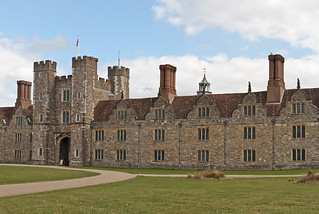
PREV ARTICLE
FULL ISSUE
PREV FULL ISSUE
A WHIFF OF HISTORY FROM BOOKS
In March we had an article about efforts at the Morgan Library & Museum in New York to capture the smells of the past. Here's an excerpt from an Art Daily piece about a similar effort in Britain to capture long-ago scents from objects in an old British manor, including books. It has a great headline: "Whiff of history: Scientists sniff out the past".
-Editor
The team has been working at Knole House in southeast England, capturing the smell of books, gloves, vinyl records and even the floor waxes. Apart from testing the objects to try to replicate their smell in the laboratory, the scientists have relied on written records about the house, which was the childhood home of novelist Vita Sackville-West. "Smells help us connect to history in a more human way," said Cecilia Bembibre, a doctoral student at University College London who has been working on the project alongside analytical chemist Matija Strlic. The project aims to identify smells that have "cultural value", as well as "ways of documenting them and hopefully preserving them", Bembibre told AFP. Strlic said studying in the historic home was crucial because objects were in their "natural habitat". "In a museum or gallery they have been taken out of context and are presented to us exclusively visually." Strlic and Bembibre published an article in the academic journal Heritage Science on Friday that included a poll of visitors to a Birmingham gallery presented with the smell of paper. Respondents were not told what the smell was, but the main words used to describe it were "chocolate", "wood" and "coffee". There were also more unusual ones, including "socks", "incense" and "farm". They also polled visitors to the 18th-century library of St Paul's Cathedral in London, who used words like "woody", "musty" and "sweet" for the smell of the books. Strlic said he was inspired a decade ago when he found out that conservationists often sniff pages to determine if books in libraries are degrading. After years of research, he said he could now accurately tell "where the paper was made, when it was made and the level of degradation" simply by its smell. He said it could also lead to the creation of archives of historic smells or the addition of an olfactory experience to museum tours.
This is an intriguing line of research. Do coins capture a record of the smells around them? Maybe not in the metal, but on the surface - what could an uncleaned original coin tell us about where it has been? If books capture scents, then paper money might as well. Taken to an extreme, could tiny traces of the past match up with DNA samples to connect a particular numismatic object with a famous person of the past? Seeking a second opinion, I wrote to our resident scientist, Bill Eckberg. Here's our exchange. -Editor
Dear Mr. Science Person: What do you think of this draft article for Sunday's E-Sylum? Is my speculation at the end totally whacky?
Dear Mr. Book Person: I have always thought that the smells in those old places were mostly mold. At least that’s how my sinuses react. I remember working in the Grad Library at the University of Michigan in the late ‘60s. They had books on the open shelves that dated to the 1600s and earlier. They had this moldy smell to them and lots of holes from insect larvae eating the cotton in the paper. Old books are one thing, but I’m not sure that most of us would enjoy the smells of the 17th century and earlier. I wouldn’t be at all surprised if coins pick up traces of the places they’re used, and that isn’t necessarily a good thing. I have some old, cull large cents on my desk right now, and you have me thinking about what and who may be all over them. I think I need to take a shower!
What will the biblio-smell-o-philes of the future make of my books? "Hmmm - Chipotle Burrito Bowl, circa 2013..." -Editor Bill adds: This reminded my wife Susan of the time I visited an early copper buddy who had recently acquired a collection from another. It reeked so badly of cigarettes that he stored the whole collection outdoors for many months just to air it out.
To read the complete article, see:
To read the earlier E-Sylum article, see:
The Numismatic Bibliomania Society is a non-profit organization promoting numismatic literature. See our web site at coinbooks.org. To submit items for publication in The E-Sylum, write to the Editor at this address: whomren@gmail.com To subscribe go to: https://my.binhost.com/lists/listinfo/esylum All Rights Reserved. NBS Home Page Contact the NBS webmaster 
|
